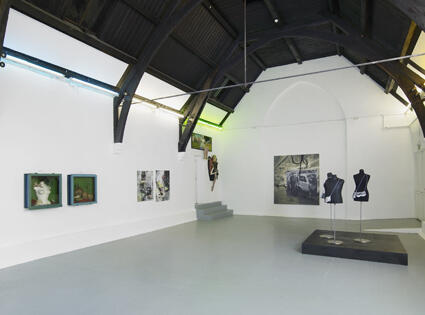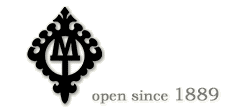Below the details of the exhibition (by courtesy of Studio Voltaire):
The Method
Devised by Paulina Olowska
With works by Władysław Hasior, Paulina Olowska, Matthias Schaufler and Wlodzimerz Wieczorkiewicz
Studio Voltaire presents The Method, an exhibition devised by Paulina Olowska including works by Władysław Hasior, Matthias Schaufler and Włodzimierz Wieczorkiewicz. The presentation will also include a new body of works made by Paulina Olowska as a response to the other artist’s work.
Three large paintings by Matthias Schaufler depict almost ghost like torsos in abstract landscapes that appear to be made up of the gestures of which the figures were made. While being aware of the sculptural form of the body and its physical weight, there is a sense of other worldliness with how the figures float almost like apparitions. The titles of Schaufler’s works often suggest some reference to narrative, for example interpreting particular Greek and religious myths. The paintings take on more of a metaphysical approach, engaging with how the body exists within the world. The figures occupy their own space, and could be understood as acting autonomously. In a sense this state of autonomy can be extended to the artist’s practice itself with his distinctive palette and style.
This idea of a figure occupying its own territory is explored in Władysław Hasior’s work Uzurpator/Usurper (circa 1970); a lion-like figure resides over his own space and makes his own rules. Hasior’s assemblages of various found objects and materials have been described as an obscure provincial variety of Pop Art mixed with Arte Povera with his use of kitsch/consumerist objects alongside more native materials and customs. The resulting practice remains difficult to name and is quite distant to the academic sculptural traditions of the time, and has more linkage to the vernacular traditions of making devotional objects in Podhale, the region of Poland where he lived. Cult and pagan symbolism runs throughout the works. The assemblages in the show are lent from Tatra Museum, Zakopane, the permanent home of his studio/gallery – a particular environment he created for the display of his works.
Włodzimierz Wieczorkiewicz’s practice is rooted within both handicraft and modernist traditions, utilising traditional craft skills to create formal compositions. His extensive practice in the Applied Arts spanned fashion items, set design, metal and leather works. Often placed within Polish and German middle class homes, these crafted works offered an alternative to the standardised objects most commonly available in the Eastern Block. Although primarily an exploration of form and material, the works reference particular signs and symbols found within objects such as shields and totems. In a similar formal chapel space to where Studio Voltaire is located, Wieczorkiewicz established The Sulmin Gallery in a village near to Gdansk in the late 1970s to display his works, as well as hosting occasional events and exhibitions of other artists. In 2005 the gallery burnt down, leaving just a few works of Wieczorkiewicz left.
The title of the exhibition – The Method – comes from both Studio Voltaire’s gallery space being a former Methodist church and the idea of method of production/working method. There is a sense with all the artists selected by Olowska of their practices sitting outside of current modes of production, that either the work could be considered outdated, unfashionable or culturally redundant. This exhibition aims to provide a platform in which the works can be reconsidered in terms of their value and status within current forms of cultural production. Production also features in the subject matter of Olowska’s paintings and collages with the inclusion of factories and workers, as well images of other artist’s work. Car factory labourers become producers of abstract sculpture objects, while other paintings attempt to capture a moment of energy in making and creativity.
Władysław Hasior (1928 - 1999, lived and worked mainly in Zakopane, Poland) had his first solo exhibition in 1961 at the Jewish Museum in Warsaw, Poland. Hasior went to exhibit internationally, notable exhibitions include Moderna Museet, Stockholm (Solo, 1968), 35th Venice Biennial (1970) and the 8th Sao Paulo Biennial (1965).
Paulina Olowska (born 1976 in Gdansk, Poland, now lives and works close to Rabka Zdrój, Poland) has had recent solo exhibitions at Simon Lee Gallery, London (2012), Foksal Gallery Foundation, Warsaw and National Museum, Krakow, Poland (2011). She also has forthcoming presentations at the Stedelijk Museum, Amsterdam and at The 56th Carnegie International, Carnegie Museum of Art, Pittsburgh. The artist has also participated in many group presentations including Museum of Modern Art, New York and New Museum, New York (2011), Migros Museum, Zurich (2010) and CCA Wattis Institute for Contemporary Art, San Francisco (2009). Olowska is represented by Buchholz Gallery, Berlin, Foksal Gallery Foundation, Warsaw; Simon Lee Gallery, London and Hong Kong; Metro Pictures, New York.
Matthias Schaufler (born 1964, Laichingen, Germany, lives and works in Berlin) has had recent solo exhibitions at Galerie Cinzia Friedlaender, Berlin (2012), Corbett vs. Dempsey, Chicago (2011, two person show with Tim Berresheim), Galerie Hammelehle und Ahrens, Cologne (2010). Schaufler is represented by
Galerie Cinzia Friedlaender, Berlin and Galerie Hammelehle und Ahrens, Cologne.
Włodzimierz Wieczorkiewicz (1945 – 2000, lived and worked mainly in Sulmin, Poland) was a sculptor, set designer and artisan. His works have been shown internationally including presentations in Germany, Poland, Norway, Great Britain and Spain.
Supported by Instytut Adama Mickiewicza (www.culture.pl)
With kind assistance from Art Logistic; Simon Lee Gallery, London; Polish Cultural Institute, London and The Method Supporter's Circle: Fiorucci Art Trust, Simon Lee, Metro Pictures & Yana Peel
With thanks to Muzeum Tatrzanskie
















